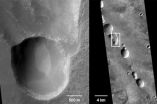A form of immune therapy might be effective for multiple myeloma
2014-05-12
(Press-News.org) COLUMBUS, Ohio – A new study by researchers at The Ohio State University Comprehensive Cancer Center – Arthur G. James Cancer Hospital and Richard J. Solove Research Institute (OSUCCC – James) provides evidence that genetically modifying immune cells might effectively treat multiple myeloma, a disease that remains incurable and will account for an estimated 24,000 new cases and 11,100 deaths in 2014
The researchers modified a type of human immune cell – called T lymphocytes, or T cells – to target a molecule called CS1, which is found on more than 95 percent of myeloma cells, and to kill the cells. The researchers grew the modified cells in the lab to increase their numbers and then injected them into an animal model where they again killed human myeloma cells.
The findings were published in the journal Clinical Cancer Research.
"Despite current drugs and use of bone marrow transplantation, multiple myeloma is still incurable, and almost all patients eventually relapse," says co-principal investigator and multiple myeloma specialist Craig Hofmeister, MD, MPH, assistant professor of medicine and a member of the OSUCCC – James Translational Therapeutics Program.
"This study presents a novel strategy for treating multiple myeloma, and we hope to bring it to patients as part of a phase I clinical trial as soon as possible," Hofmeister says.
"In particular, our study shows that we can modify T lymphocytes to target CS1, and that these cells efficiently destroy human multiple myeloma cells," says principal investigator Jianhua Yu, PhD, assistant professor of medicine and a member of the OSUCCC – James Leukemia Research Program.
"An important possible advantage to this approach is that these therapeutic T cells have the potential to replicate in the body, and therefore they might suppress tumor growth and prevent relapse for a prolonged period," Yu says.
For this study, Yu, Hofmeister and their colleagues used cell lines and fresh myeloma cells from patients to produce genetically engineered T cells with a receptor that targets CS1. The researchers then tested the capacity of the modified cells to kill human multiple myeloma cells in laboratory studies and an animal model.
The study's key technical findings include:
Compared to control T cells, the modified T cells better recognized multiple myeloma cells that overexpressed CS1, and they became more activated following the recognition;
The researchers successfully modified fresh T cells from patients and showed that the cells can be grown (expanded) in the lab, and that they efficiently recognized and eradicated myeloma cells;
In animal models, the modified T cells greatly reduced the tumor burden and prolonged overall survival: All mice that received the modified T cells were alive 44 days after treatment versus 29 percent and 17 percent of the study's two control groups.
INFORMATION:
Note: In early 2014, Ohio State cancer researchers Yu, Hofmeister and colleagues published a related study in the journal Leukemia (vol 28, pages 917) on CS1-targeted natural killer cells.
Funding from the National Institutes of Health (CA155521, OD018403), Multiple Myeloma Opportunities for Research and Education, the National Blood Foundation, and an OSUCCC – James Pelotonia Idea Grant supported this research.
Other Ohio State University researchers involved in this study were Jianhong Chu, Shun He, Youcai Deng, Jianying Zhang, Yong Peng, Tiffany Hughes, Ling Yi, Chang-Hyuk Kwon, Qi-En Wang, Steven M. Devine, Xiaoming He and Xue-Feng Bai.
The Ohio State University Comprehensive Cancer Center – Arthur G. James Cancer Hospital and Richard J. Solove Research Institute strives to create a cancer-free world by integrating scientific research with excellence in education and patient-centered care, a strategy that leads to better methods of prevention, detection and treatment. Ohio State is one of only 41 National Cancer Institute (NCI)-designated Comprehensive Cancer Centers and one of only four centers funded by the NCI to conduct both phase I and phase II clinical trials. The NCI recently rated Ohio State's cancer program as "exceptional," the highest rating given by NCI survey teams. As the cancer program's 228-bed adult patient-care component, The James is a "Top Hospital" as named by the Leapfrog Group and one of the top cancer hospitals in the nation as ranked by U.S.News & World Report.
ELSE PRESS RELEASES FROM THIS DATE:
Respect for human rights is improving
2014-05-12
By ignoring how the collection of data on political repression changes over time, human rights watchers may be misjudging reports that seem to show respect for human rights has not been improving, according to a Penn State political scientist.
Many political scientists and sociologists believe that allegations of human rights abuses drawn from sources such as the U.S. State Department and Amnesty International over the past few decades show that attention to human rights is stagnating, said Christopher Fariss, assistant professor of political science. However, a new ...
Scientists discover a natural molecule to treat type 2 diabetes
2014-05-12
Quebec City, May 12, 2014 – Researchers at the Université Laval Faculty of Medicine, the Quebec Heart and Lung Institute Research Center, and the Institute of Nutrition and Functional Foods have discovered a natural molecule that could be used to treat insulin resistance and type 2 diabetes. The molecule, a derivative of omega-3 fatty acids, mimics some of the effects of physical exercise on blood glucose regulation. The details of the discovery made by Professor André Marette and his team are published today in Nature Medicine.
It has been known for some time that omega-3 ...
The largest electrical networks are not the best
2014-05-12
This news release is available in Spanish. There is an optimum size for electrical networks if what is being considered is the risk of a blackout. This is the conclusion reached by a scientific study done by researchers at Universidad Carlos III in Madrid; the study analyzes the dynamics of these complex infrastructures.
In 1928, the British biologist and geneticist John Haldane wrote the essay "On being the right size" in which he stated that "For every type of animal there is a most convenient size, and a large change in size inevitably carries with it a change of ...
Entering adulthood in a recession linked to lower narcissism later in life
2014-05-12
We often attribute the narcissistic tendencies of others to parenting practices or early social experiences. But new research reveals that economic conditions in the formative years of early adulthood may also play a role.
The research shows that people who entered their adulthood during hard economic times are less narcissistic later in life than those who came of age during more prosperous times.
"These findings suggest that economic conditions during this formative period of life not only affect how people think about finances and politics, but also how they think ...
Round 2: Reactions serves up a second helping of chemistry life hacks (video)
2014-05-12
WASHINGTON, May 12, 2014 — It was the video that started it all, and now the latest installment of the segment that is one-part Mendeleev, one-part MacGyver is here. The American Chemical Society's (ACS') Reactions video team is proud to debut round two of chemistry life hacks. This volume is packed full of new chemistry-fueled solutions for everyday problems, like spotting rotten eggs, reviving soggy green vegetables and fixing busted buttons. The video is available at http://youtu.be/ReGfd_s9gXA
INFORMATION:
Subscribe to the series at Reactions YouTube, and follow ...
Triple negative breast cancer, ethnicity, and socioeconomic status
2014-05-12
ATLANTA – May 12, 2014—An analysis of a large nationwide dataset finds that regardless of their socioeconomic status, black women were nearly twice as likely as white women to be diagnosed with triple-negative (TN) breast cancer, a subtype that has a poorer prognosis. The analysis also found that Asian/Pacific Islander women were more likely to be diagnosed with another subtype of breast cancer: so-called human epidermal growth factor receptor 2 (HER2)–overexpressing breast cancer. The study appears early online in Breast Cancer Research and Treatment.
Triple-negative ...
Hospitals recover from recession, some financial issues remain
2014-05-12
The recent economic recession affected hospitals across the nation, regardless of financial status, but following the rebound, financially weak and safety-net hospitals continue to struggle, according to health researchers.
"Poor financial outcomes [for hospitals] could lead to poor care," said Naleef Fareed, assistant professor of health policy and administration, Penn State. "This is an issue that needs attention as health care reform moves forward."
Fareed and colleagues used data from both the American Hospital Association Annual Survey and the Centers for Medicare ...
Man's best friend shares similar 'albino' gene
2014-05-12
Michigan State University researchers have identified a genetic mutation in Doberman pinschers that causes albinism in the breed, a discovery that has eluded veterinarians and breeders worldwide up until now.
Paige Winkler, a doctoral student in the College of Veterinary Medicine, co-led the study with Joshua Bartoe, an assistant professor in the Department of Small Animal Clinical Sciences, and discovered a mutated gene that is associated with a form of albinism in humans.
"What we found was a gene mutation that results in a missing protein necessary for cells to ...
Against the current with lava flows
2014-05-12
This news release is available in German.
An Italian astronomer in the 19th century first described them as 'canali' – on Mars' equatorial region, a conspicuous net-like system of deep gorges known as the Noctis Labyrinthus is clearly visible. The gorge system, in turn, leads into another massive canyon, the Valles Marineris, which is 4,000 km long, 200 km wide and 7 km deep. Both of these together would span the US completely from east to west.
As these gorges, when observed from orbit, resemble terrestrial canyons formed by water, most researchers assumed that ...
Drug therapy for allergy moves forward
2014-05-12
Researchers have identified several target molecules which are suitable for the development of new allergy drugs. The Journal of Allergy and Clinical Immunology, the most prestigious journal in the field of allergology, has recently published an extensive review article on the prospects of drug therapy for allergy. Completed in a large-scale EU project, the lead author of the review article is Professor Ilkka Harvima of the University of Eastern Finland and Kuopio University Hospital.
Immediate allergic reactions and allergic diseases such as allergic rhinitis, asthma ...



